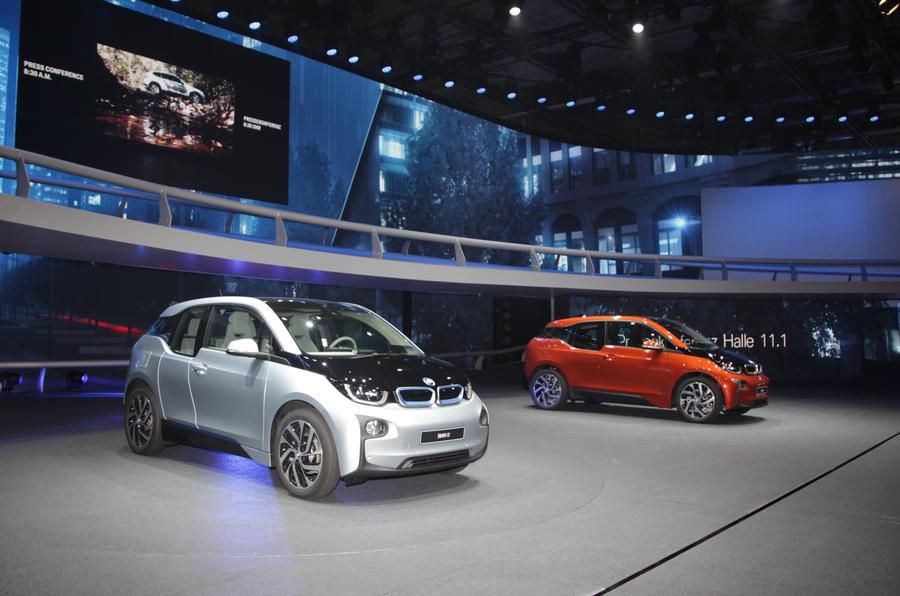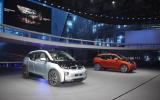The BMW i3 has made its first public appearance at the Frankfurt motor show today as the part of what the German car maker promises will be a complete range of alternative drive models to be sold under its new i brand.
The i3 is a contemporary-styled hatchback that remains faithful in basic appearance to the earlier i3 concept revealed at the 2011 Frankfurt motor show but adopts a five door bodystyle in place of the original three door arrangement for added practicality and ease of entry to the rear.
The i3 is priced at £30,680, but with a £5000 electric car rebate it will end up costing buyers £25,680 in the UK. Alternatively, BMW is also offering the i3 on a three year lease scheme with a deposit of £2995 and 36 monthly payments of £369.
Conceived under the working title Mega City Vehicle – a name meant to focus attention on its suitability for urban driving, the i3 represents a number of firsts for BMW, which is reputed to have spent up to €2 billion in research, development, testing and production processes for the new four-seater.
Included among the innovations adopted on the BMW i brand’s initial model is a lightweight inner body structure made entirely out of carbon fibre sourced from US-based SGL Carbon but woven and cured at BMW’s plant in Landshut, Germany.
At 1195kg, the i3 weighs 90kg less than the existing 114i despite using a battery that is claimed to weigh a significant 230kg. The inherent strength of the assembly used to support its carbon fibre reinforced body panels has allowed BMW’s design team to do away conventional B-pillars and provide rear-hinged coach style doors at the rear.
At 3999mm in length, 1775mm in width and 1578mm in height, the i3 is 326mm shorter, 10mm wider and 158mm taller than the second-generation 1-series hatchback. It rides on a chassis whose wheelbase is 120mm shorter than that of its existing entry level model at 2570mm, providing the new electric car with relatively short 707mm front and 722mm rear overhangs.
The i3 is the first series production BMW to rely purely on electricity for propulsion. But in move harking back to the company’s most illustrious combustion engine models it eschews front-wheel drive for a more traditional rear wheel drive layout in the interests of interior packaging, low speed maneuverability and what officials describe as class leading steering response.
Power is provided by a synchronous electric motor mounted within an aluminium sub-assembly above the rear axle. The in-house produced unit, known under the BMW eDrive banner, provides 168bhp and 184lb ft of torque – some 10bhp less but 5lb ft more than the Mini Cooper S’s turbocharged 1.6-litre four-cylinder direct injection petrol engine. Drive is sent through a single ratio gearbox mounted to the end of the electric motor, offering the choice of three driving modes: Comfort, Eco Pro and Eco Pro+.






































































Join the debate
Add your comment
What the hell is this monstrosity?
I've seen some ugly cars in my time but this takees the biscuit. No doubt plenty will buy it as they would Dolce & Gabbana's newest pair of choes but I think it is absolutely hideous. Vastly over-designed and as someone else said entirely unresolved. The back is worse than a City Rover and probably the ugliest arse on a car I have ever seen. It, and to a lesser extent the front, remind me of a drawing I saw in a bar once of a pissed bloke's head with two setos of eyes and features, one slightly above the other. It made you squint and blink. This thing does the same. For all this I'm sure it is well engineered and very clever, but I would never consider an all-electric vehicle. The range extender is the only one that makes any sense at all but even that has limited range as the small engine does not drive the car but just produce electricity bvy the sound of it.
Thank goodness for Jaguar is all I can say. At least there remains a quality car maker committed to making beautiful looking cars. They have their own tech project but are in no rush given the small market. A proper hybrid (i.e. not like the i3) might make sense in the end but the engine needs to be there to help drive the vehicle as well I think. And given the fact that the German brands are the world's worst offenders we read at over-stating their cars' official figures I think we should wait until the Top Gear boys and others like this esteemed journal have given these things a really good run out and pitted them in real world conditions against frugal and clean conventional (and far more convenient) engines and other more standard hybrids. I'll believe the hype only then, but I still wouldn't dream of buying one. I'd never buy anything this ugly. Sorry, but there it is.
I'm usually sceptical when it
I'm usually sceptical when it comes to EVs, but there's something about the i3 which seems to make it a more realistic proposition.
The styling is clearly divisive and unconventional, but at least it looks futuristic and advanced compared to most things on the road. Surely if BMW are backing EVs as "the future" then they need to look like they've come from the future first.
I also like the BMW Access scheme which lets you accrue points to lease a regular internal combustion engined BMW for longer journeys. That seems to be something no other manufacturer has thought of.
Im sorry but how on earth is
Im sorry but how on earth is this car piorneering? There is NO new tech at all on the car. It is just another EV but thanks to the badge displayed on the bonnet many will buy it thinking its a first and the best. Its not. And as for the looks well my dog looks better when doing her squating.
I would like to weigh in to the EV or Hydrogen car debate as well with something has not been mentioned. Have you noticed how our government is stalling with new nuclear which is the ONLY way we can gurantee our future supplies. Due to bad planning there will be a power shortage if we dont get building right now, good luck charging them then.